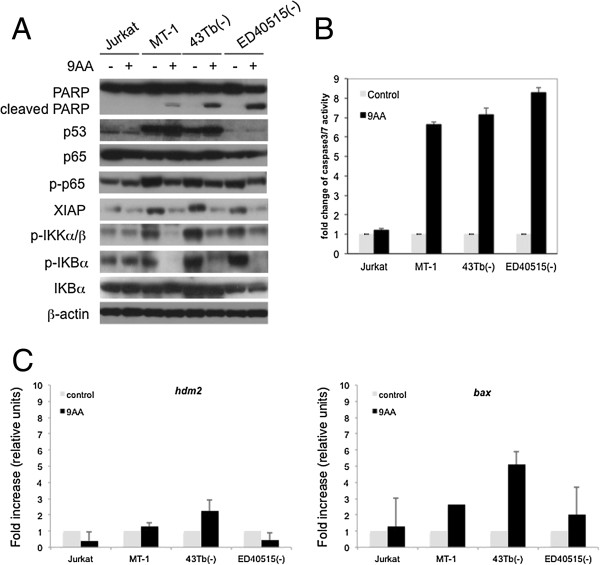Figure 3.

9AA increased expression of p53 and activity of caspase-3/7, downregulated the NF-κB pathway, and induced apoptosis in ATL cell lines. Jurkat, MT-1, ED40515 (-), and 43 Tb (-) cells were treated for 48 hours with and without 9AA at 5 μM. Data are representative of 3 independent experiments. (A) Western blot analysis of the expression levels of proteins in ATL cell lines before and after 9AA treatment. Cell lysates were immunoblotted with the indicated antibodies: PARP, p53, phospho-p65, p65, XIAP, and phosph-IKKα/β, phosphr-IκBα and IκBα. β-actin was used as an input control. (B) Detection of caspase-3/7 activity in ATL cell lines before and after 9AA treatment. Cells were measured for the activities of caspase-3/7. Fold change was calculated based on the activity of caspase-3/7 before treatment. Data are representative of 3 independent experiments and are presented as means ± SD. (C) Induction of p53 responsive genes in 9AA treated cells. Total cellular mRNA was extracted from cell lysates of 9AA (10 μM) or control cells 48 hours after treatment. Quantitative PCR was performed to measure the expression levels of hdm2 (left panel) and bax (right panel) genes. RNA levels of control treated cells were set at 1. Each sample was run in triplicate from two independent experiments. The MT1 cell line was run in triplicate from one experiment. Expression levels of p53 responsive genes were normalized to expression of gapdh for each cell line tested.
